A Historic Milestone: the 2023 ISCM World New Music Days in South Africa

(Photos by Frank J. Oteri)
INTRODUCTION
The 2023 ISCM (International Society for Contemporary Music) World New Music Festival (WNMD) was a historic milestone, the first time this prestigious festival was held on the African continent. Taking place from 24 November to 3 December in Johannesburg, Soweto and Cape Town, South Africa, the festival not only celebrated the 100th anniversary of the ISCM, but also showcased Africa’s rich musical heritage and a diverse range of contemporary musical works from around the world. As Secretary of the ISCM Shanghai Chapter, I present in this report a detailed account of the festival, which encompassed the rich diversity of musical works, the unique sound of African instruments, and the innovative expression of multiculturalism in contemporary music.
I. African traditional music and instruments
African traditional music played an important role in the Festival, highlighting the continent’s rich cultural heritage and the unique sound of African traditional instruments. The Festival showcased a large number of African traditional instruments, each with its own unique sound and historical significance.
1. The kalimba and traditional bow
The kalimba, also known as the thumb piano, is a percussion instrument with metal keys that is played by the thumb to produce sound. Its resonant and pleasing sound is an important part of many African musical traditions. The fascinating sound of the kalimba was highlighted by a performance of the traditional South African female duet ‘Ancient Voices’. They also played the traditional bows of Southern Africa, which are the ancestors of the Brazilian berimbau. The deep resonating sound of these bows provided the audience with an insight into the musical culture of Southern Africa. The duo not only showcased their unique vocal skills and voices, but also vividly told the stories and traditions of their community through their music. The use of these traditional instruments in a contemporary setting demonstrates the diversity of Africa’s musical heritage and the enduring relevance of cultural transmission.
2. Marimba
The marimba plays an important part in many African musical traditions and its warm resonant tones were frequently heard throughout the festival. The ‘Education Africa’ marimba band gave a rousing performance, demonstrating the marimba’s ability to produce complex rhythms and melodies. Their performance demonstrated the versatility of the marimba and its key role in both traditional and contemporary African music.
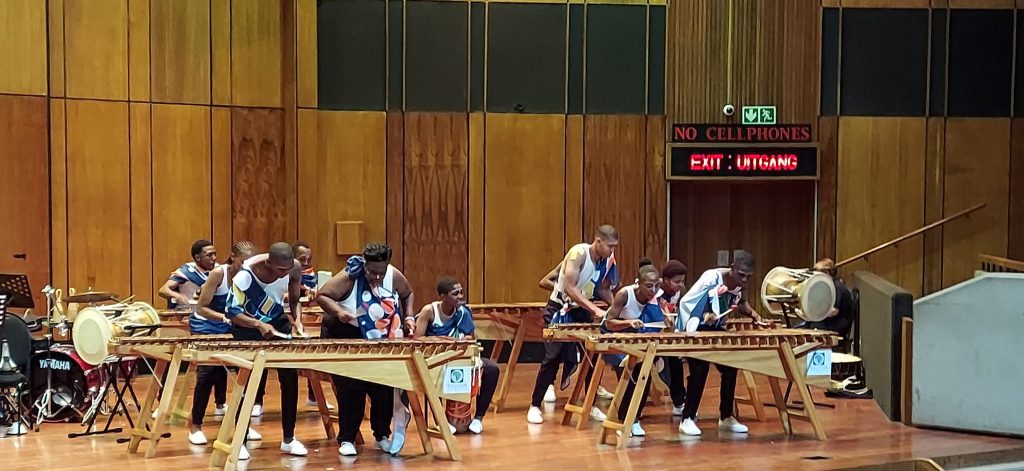
The marimba is also featured in various contemporary works, demonstrating its adaptability and the unique textures it brings to contemporary music. For example, Bernett Nkwayi Mulungo’s performance of ‘Gazankulu Suite’ demonstrates the seamless integration of the marimba with other instruments to create a rich and complex soundscape. Inspired by the civilisational heritage of the Gazankulu people, the suite combines traditional rhythms with contemporary harmonic structures, demonstrating the stunning dynamic range and expressive potential of the marimba.
3. Talking drums and other percussion instruments
African music is renowned for its complex rhythms and extensive use of percussion instruments. The festival showcases a wide range of traditional African percussion instruments, including the talking drum, the kimbeh and various types of tambourines. These instruments are known for their ability to produce a wide range of tones and pitches, often mimicking human speech.
A highlight was a performance by master drummer David Odoom from Ghana, who transformed a drum set into a percussion ensemble performance effect. His use of multiple talking drums to create complex rhythmic patterns and convey stories through music was particularly compelling. The talking drums, with their ability to adjust pitch and produce a wide range of sounds, played a crucial role in his performance, demonstrating the unique charm and musical communication capabilities of his instrument.
4. Contemporary works inspired by African music
The festival also showcases contemporary works inspired by African musical traditions. These works often combine traditional elements with contemporary compositional techniques to create innovative and engaging compositions that reflect a fusion of the traditional and the contemporary.
An impressive example of this was Lukas Ligeti’s Suite for Burkina Electric and Orchestra. The work was one of the festival’s most impressive performances, featuring the Mzansi National Philharmonic Orchestra and Burkina Electric, and was a perfect blend of traditional African rhythms and melodies with contemporary electronic music. Ligeti’s work highlights the dynamic interplay between traditional sounds and electronic music, creating a rich, layered soundscape that is both innovative and deeply rooted in African musical traditions. The piece features Maï Lingani (vocals), Abdoulaye Kouanda (guitar), and Lukas Ligeti (electronics and drums), with dancers and background singers Zoko Zoko and Vicky Lamour. the fusion of electronic music, such as synthesised and looped sounds, adds a digital touch to traditional African music (‘Digitalised’), creating a soundscape that is both innovative and deeply rooted in African musical tradition. The rhythmic complexity and melodic richness of the work demonstrates Ligeti’s ability to cross cultural and musical boundaries and is the centrepiece of the festival.
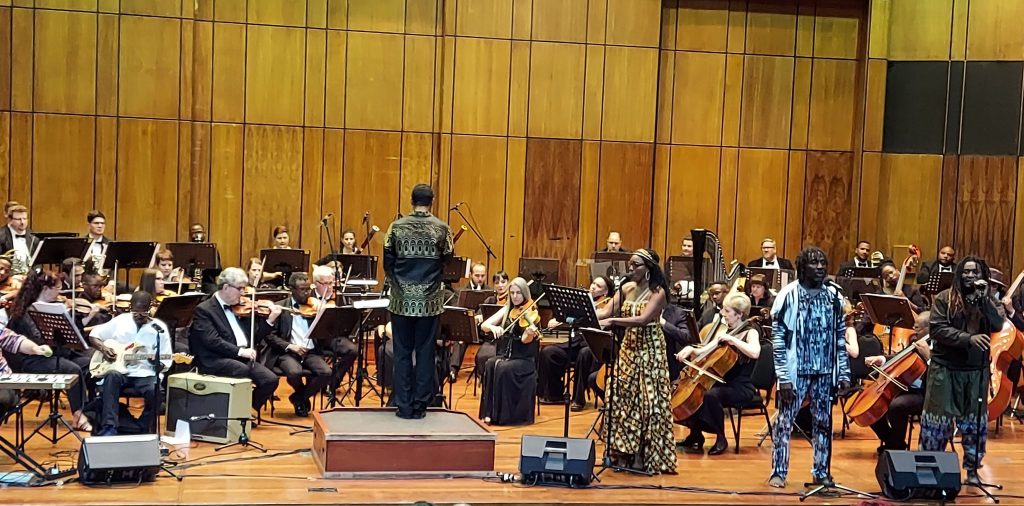
Michael Mosoeu Moerane’s Fatše la Heso (My Country) is a choral work celebrating the composer’s native Lesotho. Performed by a local choir, the work demonstrates the use of traditional African harmonic structures and melodic themes in a contemporary choral setting. The composer demonstrated the rich vocal traditions of southern Africa, characterised by complex harmonic and intervocalic echo patterns. The performance touched the audience deeply, and the choir’s powerful voices reverberated through the arena, creating an atmosphere of awe and pride.’ Fatše la Heso is a testament to the enduring legacy of traditional African music, demonstrating its ability to convey deep emotional and cultural messages. Combining traditional elements with contemporary choral techniques, the work highlights the versatility and depth of the African musical tradition.
Bongani Ndodana-Breen’s Visions for Solo Flute is a contemporary work inspired by traditional African music. Featuring a solo flute, the work explores the flute’s extended contemporary playing techniques, including polyphony, vibrato and microtonality. These techniques are combined with rhythmic patterns inspired by African drumming to create a unique and engaging soundscape. The work highlights the versatility of the flute and its ability to produce a wide range of tones and effects. The structure of the piece is characterised by its smooth transitions and dynamic contrasts, reflecting the ‘improvisational’ and ‘random’ feel of traditional African music.’ Visions is a striking example of how contemporary composers are drawing inspiration from traditional musical forms to create innovative and expressive works.
Electronic and Fixed Media Music
Electronic and fixed-media music played an important role in the festival, demonstrating the intersection of contemporary computer technology and traditional music. These genres of music involve the manipulation of sound through electronic means, often resulting in immersive and experimental listening experiences.
1. Electronic music concerts
Electronic music concerts at the Goethe-Institut and other venues have demonstrated the potential of electronic music to create new timbres. Despite challenges such as the lack of local electricity, these performances were extraordinary, with pieces such as Dances for a Gathered Storm by Cameron Harris and Music for Electronic Table by Daniel Muhuni Mbutch Mjingoma highlighting the innovative use of computer manipulation to enhance the soundstage of traditional music. Dances for a Gathered Storm utilises field recordings of natural sounds, computer manipulation and live performance to create an immersive listening experience. The work explores the dynamic interplay between natural and synthesised sounds to create a rich, layered soundscape that is both evocative and engaging, and Harris’s use of electronic effects such as reverb, delay and sample-fragmentation synthesis adds depth and complexity to the work, enhancing its overall impact. Mjingoma’s Music for Electronic Table was another highlight, showcasing the innovative use of electronic sounds to create unique and engaging soundscapes. The piece combines pre-recorded sound, live electronic processing and improvisation to create a dynamic and unpredictable listening experience. The composer’s use of extended techniques, such as live sampling and looping, adds to the spontaneity and unpredictability of the performance, demonstrating the creative potential of electronic music.
2. Fixed media music
Fixed media music, in which pre-recorded sounds are played during a live performance, is also a highlight of the festival. This genre allows composers to craft soundscapes that blend natural and synthesised sounds. Fixed media works from around the world, particularly by South African composers, demonstrated the creative possibilities of this medium.
One notable performance was The Bells by Cris Derksen, a Canadian composer of indigenous and African ancestry. The piece combines pre-recorded sounds of bells and other metallic percussion instruments to create an eerie and ethereal soundscape. The composer’s use of fixed media allows for precise control over the timing and placement of sounds, creating a coherent and immersive listening experience. The combination of electronic and acoustic elements adds depth and richness to the work, enhancing its overall aural quality.
Chamber Music Performance
Chamber music performances are at the heart of the festival, showcasing a diverse range of works and highlighting the collaborative spirit of contemporary music. These performances demonstrate the technical proficiency and versatility of the musicians, as well as the innovative potential of contemporary chamber music.
The Ensemble Modern from Frankfurt gave several outstanding performances, including contemporary classics such as Unsuk Chin’s Fantaisie Mécanique, Gérard Grisey’s Talea, and György Ligeti’s Piano Concerto. These works, characterised by their complex structures and innovative use of timbre, highlight the virtuosity and adaptability of the ensemble.
Unsuk Chin’s Fantaisie Mécanique is a highly dynamic and rhythmically complex work that explores the intersection of acoustic and electronic sound worlds. The orchestra’s precise interpretation of complex rhythmic patterns and timbral variations demonstrates their technical proficiency and interpretive skills. The composer’s use of special virtuosic, extended techniques, such as preset pianos and electronic musical control, add depth and complexity to the work, creating a rich and immersive listening experience.
Gérard Grisey’s Talea is an important work in the genre of spectral music, characterised by a focus on the acoustic properties of sound and the use of differential intervals. The ensemble’s performance highlights the work’s extreme nuances and rich sonic textures, creating a mesmerising and transcendent soundscape. The interaction between the timbres of the different instruments and the precise control of dynamics and intonation demonstrated the ensemble’s mastery of this challenging repertoire.
György Ligeti’s Piano Concerto is a virtuosic and artistically demanding work that explores the limits of pianistic virtuosity and expressiveness. The orchestra’s collaboration with pianist Jan Satler resulted in a thrilling and electrifying performance that showcased the technical and interpretive abilities of both soloist and orchestra. The composer’s use of complex rhythms, shifting beats, and an extended and tonal language creates a dynamic and exciting listening experience.
Hungary’s UMZE Ensemble performs contemporary works from around the world, including those submitted by ISCM chapters. Their performances included both solo and chamber works, demonstrating the versatility and technical proficiency of the musicians. Amy Crankshaw’s Golden Hour was a highlight, demonstrating the ensemble’s ability to interpret and perform with precision in contemporary music. The work is characterised by its ‘starry’ sound weave and smooth transitions, creating a mesmerising and ethereal soundscape. The orchestra’s precise control of articulation and articulation, as well as the balancing and blending of different instrumental timbres, resulted in an engaging and expressive performance.
Solo performances
The Festival also featured a number of solo performances that highlighted the individual virtuosity of the performers, the expressive potential of the solo instruments and the innovative potential of contemporary solo music.
1. Pianists William Chapman Nyaho and Kathleen Tagg
Pianists William Chapman Nyaho and Kathleen Tagg gave extraordinary performances, with each artist bringing a unique interpretation of contemporary works. with contemporary piano techniques.
Joshua Uzoigwe’s ‘Ukom’ from Talking Drums is a virtuosic and rhythmically complex work inspired by traditional African drumming rhythms. His performance highlights the complex rhythmic interplay and dynamic contrasts in the work, demonstrating his technical proficiency and artistic interpretation. The work combines African rhythmic patterns with a contemporary harmonic language to create a rich and engaging listening experience.
Gyimah Labi’s ‘Lullaby’ from Dialects in African Pianism is a lyrical and expressive work that explores the melodic and harmonic potential of the piano. The sensitive and delicate playing highlights the subtle interplay between different musical elements, creating a mesmerising and expressive soundscape. The work combines traditional African melodies with contemporary harmonic language, demonstrating the versatility and expressive potential of the piano.
Kathleen Tagg performed her own composition Berimbau, highlighted by the choice of saxophonist Mark Fransman as an accompanist. Inspired by the traditional Brazilian instrument Berimbau, the piece combines African rhythmic patterns, melodic motifs and a contemporary harmonic language; Tagg’s virtuosic piano playing and Fransman’s expressive saxophone playing create a dynamic and engaging listening experience. The works combine traditional and contemporary elements, highlighting the innovative potential of modern music.
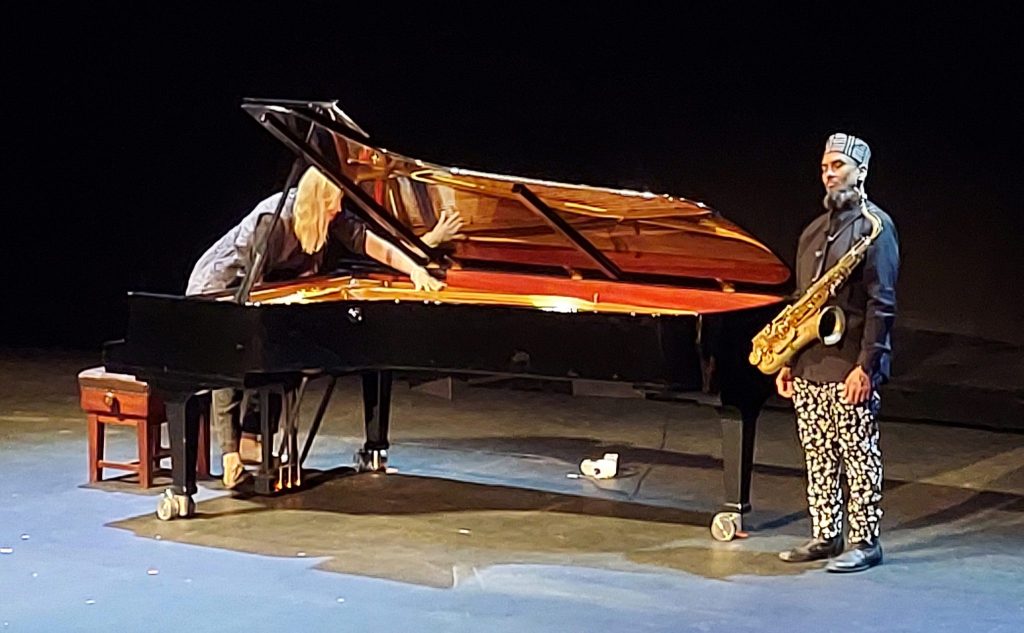
2. Gergely Ittzés, flute
Hungarian flutist Gergely Ittzés demonstrates the wide range of possibilities for the flute as a solo woodwind instrument through a series of his own compositions and those of other composers. His playing further develops the mantle of Mr Robert Dick, a pioneer in the development of flute technique in the United States, and highlights the innovative potential of the flute in contemporary music.
A notable performance was Ittzés‘ interpretation of Robert Dick’s Lookout, a work that explores the flute’s extended techniques, including polyphony, vibrato, and microtones, etc. Ittzés’ precise control of these techniques, as well as his expressive interpretation of the work, created a mesmerising and engaging listening experience. The exploration of the flute’s sonic possibilities highlights the instrument’s versatility and expressive potential, and Ittzés also performs his own composition, Fantasia, which demonstrates the flute’s ability to produce a wide range of timbres and effects. Characterised by its smooth transitions and dynamic contrasts, the piece reflects one of the qualities of traditional African music – ‘rich improvisation’ – and Ittzés’ virtuosic and innovative use of flute extensions creates a rich and engaging aural experience, demonstrating the potential of the flute in contemporary music. Ittzés’ virtuosity and innovative use of flute extensions create a rich and compelling aural experience that demonstrates the creative potential of the flute in contemporary music.
V. Improvisation and intercultural collaboration
Improvisation and cross-cultural collaboration are key themes running through the festival, highlighting the spontaneous and collaborative nature of contemporary music. The performances emphasised the importance of cultural exchange and the fusion of different musical traditions.
1. African traditional musicians
The performances by traditional musicians from Lesotho, Ghana, and Uganda are testimony to the richness and diversity of African musical traditions. Their improvisations, often characterised by interlocking rhythms and echoing patterns, captured the audience’s attention and provided a deep connection with African cultural roots.
2. Cross-cultural collaboration
Cross-cultural collaborations are a highlight of the festival, where musicians from different backgrounds come together to create unique and innovative performances. These collaborations emphasise the importance of cultural exchange and the fusion of different musical traditions.
One notable collaboration was between Basque xylophone duo Oreka TX (Harkaitz Martinez de San Vicente and Mikel Ugarte) and Ugandan percussionists Bisaso Albert Ssempeke and James Isabirye, directed by Mexican composer Ernesto Martínez. Their performance combined elements of Basque and Ugandan music, creating a mesmerising clash of cultures that captured the audience’s attention. The interlocking rhythms and melodic motifs between the different percussion instruments created a rich and dynamic soundscape, highlighting the innovative potential of cross-cultural collaboration.
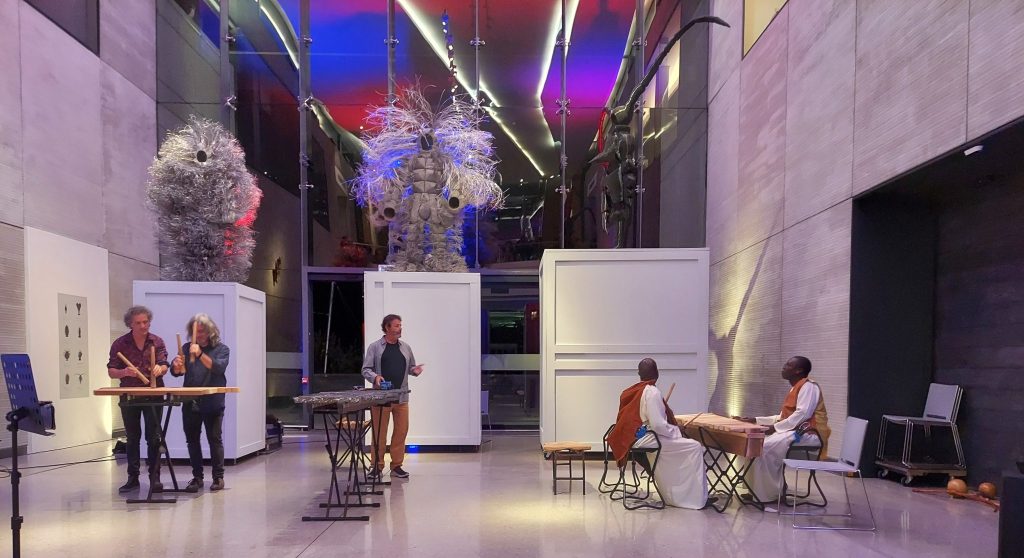
Another highlight was the performance of the Simon Estes Alumni Choir, conducted by Monwabisi Mbambani. The choir is made up of singers from different cultural backgrounds and performs a repertoire that includes traditional African choral music, contemporary works and adaptations of popular songs. Their performance demonstrated the rich vocal traditions of different cultures and that choral music unites people through a musical experience that encompasses the characteristics of each culture and name.
Conclusion
The ISCM World Festival of New Music 2023 in South Africa was a landmark event that celebrated and showcased the richness and diversity of African musical cultures. The festival provided a platform for African musicians to showcase their talents and for international audiences to experience Africa’s unique sound and musical expression. By combining traditional African elements with contemporary compositional techniques, the festival highlighted the innovative potential of African music.
This historic event not only embodies the 100th anniversary of the International Society for Contemporary Music (ISCM), but also paves the way for future festivals to explore new territories and embrace the diversity of musical and cultural traditions across the globe, setting an example for future events and highlighting the importance of embracing innovation and collaboration while preserving cultural heritage. We look forward to future ISCM World New Music Festivals that will continue to foster global cultural exchange and celebrate the diversity of contemporary music from around the world. This event sets a high standard for future festivals and demonstrates the importance of inclusivity and cultural exchange in the contemporary music world.
2023 ISCM世界新音乐节(南非)的报告
彭荣鑫
ISCM上海分会秘书

引言
2023年国际当代音乐协会(ISCM)世界新音乐节(WNMD)是一个历史性的里程碑,这是第一次在非洲大陆举行的这一著名音乐节。该活动于11月24日至12月3日在南非的约翰内斯堡、索韦托和开普敦举行,这次音乐节不仅庆祝了国际当代音乐协会成立100周年,还展示了非洲丰富的音乐遗产和来自世界各地的、多样化的当代音乐作品。作为ISCM上海分会的秘书,我在此报告中详细介绍了音乐节的盛况,音乐节包含音乐作品丰富的多样性、非洲乐器的独特音色以及多元文化在当代音乐中的创新表达。
一、 非洲传统音乐与乐器
非洲传统音乐在本次音乐节中发挥了重要作用,突出展示了非洲大陆丰富的文化遗产和非洲传统乐器的独特音色。音乐节展示了大量非洲传统乐器,每一种乐器都有其独特的声音和历史意义。
- 卡林巴和传统弓
卡林巴,也被称为拇指钢琴,是一种带有金属键的打击乐器,通过拇指弹奏发声。它的声音共鸣且悦耳,是许多非洲音乐传统中的重要组成部分。南非的传统女性二重唱“Ancient Voices”的表演突显了卡林巴迷人的音色。她们还演奏了南部非洲的传统弓,这些弓是巴西贝林巴乌的祖先。这些弓发出的深沉共鸣音,为观众提供了一个深入了解南部非洲音乐文化的机会。二重唱不仅展示了她们独特的声乐技巧和声线,还通过音乐生动地讲述了她们社区的故事和传统。在现代环境中使用这些传统乐器,展示了非洲音乐遗产的多样性和文化传承的持久相关性。
- 马林巴琴
马林巴琴在许多非洲音乐传统中占据重要地位,其温暖的共鸣音色在整个音乐节中频频出现。“Education Africa”马林巴乐队带来了令人振奋的表演,展示了马林巴琴在产生复杂节奏和旋律方面的能力。他们的表演展现了马林巴琴的多功能性及其在传统和现代非洲音乐中的关键作用。
马林巴琴也在各种当代作品中出现,展示了其自适应性和给当代音乐中带来的独特质感。例如,Bernett Nkwayi Mulungo的”Gazankulu Suite”的表演展示了马林巴琴与其他乐器的无缝融合,创造出丰富且复杂的音景。这部组曲受Gazankulu人民的文明遗产启发,结合了传统节奏和当代和声结构,展示了马林巴琴令人震撼的动态范围和表现潜力。
- 谈话鼓和其他打击乐器
非洲音乐以其复杂的节奏和广泛使用的打击乐器而闻名。音乐节展示了各种非洲传统打击乐器,包括谈话鼓、金贝鼓和各种类型的手鼓。这些乐器以其能够产生多种音调和音高,常常模仿人类语言而著称。
来自加纳的大师鼓手David Odoom的表演是一个亮点,他将一套鼓变成了一个打击乐团的演出效果。他使用多个谈话鼓来创造复杂的节奏模式并通过音乐传达故事,特别引人注目。谈话鼓由于能够调节音高并产生宽广的音域,在他的表演中起到了至关重要的作用,展示了其乐器独特的魅力和音乐交流能力。
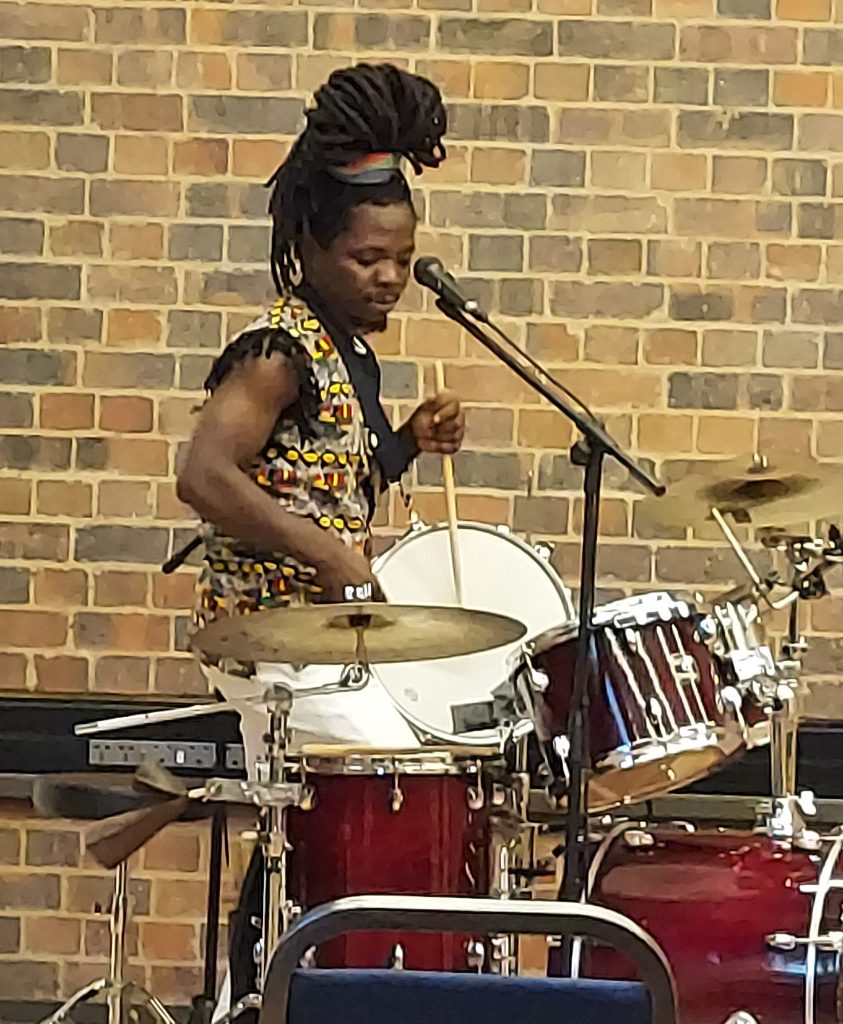
- 受非洲音乐启发的现代作品
音乐节还展示了受非洲音乐传统启发的当代作品。这些作品通常将传统元素与当代作曲技术相结合,创造出创新且引人入胜的作品,反映了传统与当代的融合。
令人印象深刻的有Lukas Ligeti的“Suite for Burkina Electric and Orchestra”。该作品是音乐节中令人印象深刻的表演,由Mzansi National Philharmonic Orchestra和Burkina Electric演奏,它完美融合了传统的非洲节奏、旋律与当代电子音乐。Ligeti的作品突出了传统声音和电子音乐之间的动态互动,创造出丰富、层次分明的音景,既创新又深植于非洲音乐传统。该作品由Maï Lingani(主唱)、Abdoulaye Kouanda(吉他手)和Lukas Ligeti(电子音乐和鼓)演奏,配以舞者和背景歌手Zoko Zoko和Vicky Lamour。电子音乐的融合,如合成音和循环音,为传统非洲音乐增添了数字感(Digitalized),创造出动态且引人入胜的效果。作品的节奏复杂性和旋律丰富性展示了Ligeti跨越文化和音乐界限的能力,成为本次音乐节的核心作品。
Michael Mosoeu Moerane的”Fatše la Heso”(我的国家)是一部庆祝作曲家祖国莱索托的合唱作品。由当地合唱团演奏,这部作品展示了在当代合唱环境中使用传统的非洲和声结构和旋律主题。作曲家展示了南部非洲丰富的声乐传统,其特点是复杂的和声和声部之间的呼应模式。这场演出深深打动了观众,合唱团强有力的声音在场馆中回荡,营造出一种敬畏和自豪的氛围。”Fatše la Heso”是传统非洲音乐传承不息的见证,展示了其传达深刻情感和文化信息的能力。作品结合传统元素与当代合唱技术,突显了非洲音乐传统的多功能性和深度。
Bongani Ndodana-Breen的”Visions for Solo Flute”是一部受传统非洲音乐启发的当代作品。该作品由长笛独奏,探索了长笛的当代延伸演奏技巧,包括复调音、颤舌和微分音等。这些技巧与受非洲鼓点启发的节奏型相结合,创造出独特且引人入胜的音景。作品突出了长笛的多功能性及其产生广泛音色和效果的能力。作品结构以其流畅的过渡和动态对比为特征,反映了传统非洲音乐的“即兴感”和“随机感”。”Visions for Solo Flute”是当代作曲家如何从传统音乐形式中汲取灵感,创造出创新且富有表现力的作品的一个引人注目的例子。
二、 电子音乐和固定媒体音乐
电子音乐和固定媒体音乐在音乐节中发挥了重要作用,展示了当代计算机技术与传统音乐的交汇点。这些音乐类型涉及通过电子手段操纵声音,通常带来身临其境和实验性的听觉体验。
- 电子音乐音乐会
在歌德学院和其他场馆举办的电子音乐音乐会展示了电子音乐在创造新音色方面的潜力。尽管面临如当地电力不足等挑战,这些表演依然非凡。Cameron Harris的”Dances for a Gathered Storm”和Daniel Muhuni Mbutch Mjingoma的”Music for Electronic Table”等作品突显了电脑操纵在增强传统音乐声场方面的创新使用。
Cameron Harris的”Dances for a Gathered Storm”利用自然声音的现场录音、电脑操纵和现场表演,创造了身临其境的听觉体验。该作品探索了自然声音和合成声音之间的动态互动,创造出丰富、层次分明的音景,既引发联想又引人入胜。Harris对电子效果的使用,如混响、延迟和采样碎片化合成等,增加了作品的深度和复杂性,增强了其整体影响力。
Daniel Muhuni Mbutch Mjingoma的”Music for Electronic Table”是另一个亮点,展示了电子声音在创造独特且引人入胜的音景方面的创新使用。该作品结合了预录声音、现场电子处理和即兴表演,创造出动态且不可预测的听觉体验。作曲家对延伸技术的使用,如现场采样和循环,增加了表演的自发性和不可预测性,展示了电子音乐的创作潜力。
- 固定媒体音乐
固定媒体音乐,即在现场演出中播放预录声音,也是音乐节的一大亮点。这种类型允许作曲家精心制作融合自然和合成声音的音景。来自世界各地的固定媒体作品,特别是南非作曲家的作品,展示了这一媒介的创作可能性。
一个值得注意的表演是Cris Derksen的”The Bells”,这位加拿大作曲家有着土著和非洲血统。该作品结合了钟声和其他金属打击乐器的预录声音,创造出一种令人毛骨悚然且空灵的音景。作曲家对固定媒体的使用允许对声音的时间和位置进行精确控制,创造出连贯且身临其境的听觉体验。电子和声学元素的结合为作品增添了深度和丰富性,增强了其整体听感。
- 室内乐表演
室内乐表演是音乐节的核心,展示了多样化的作品并突显了当代音乐的协作精神。这些表演展示了音乐家技术水平和“多功能性”,以及当代室内乐的创新潜力。
来自法兰克福的Ensemble Modern乐团带来了几场杰出的表演,包括近当代经典作品如Unsuk Chin的”Fantaisie Mécanique”、Gérard Grisey的”Talea”和György Ligeti的钢琴协奏曲。这些作品以其复杂的结构和创新的音色使用为特点,突显了乐团的精湛技艺和适应能力。
Unsuk Chin的”Fantaisie Mécanique”是一部极具动感和节奏非常复杂的作品,探索了声学和电子声音世界的交汇点。乐团对复杂节奏模式和音色变化的精确演绎展示了他们的技术娴熟和诠释能力。作曲家对特殊演奏法、延伸技巧的使用,如预置钢琴和电子音乐控制,为作品增添了深度和复杂性,创造出丰富且身临其境的听觉体验。
Gérard Grisey的”Talea”是频谱音乐体裁中的重要作品,其特点是关注声音的声学特性和微分音音程的使用。乐团的表演突显了作品中极细微差别和丰富的声部纹理,创造出令人着迷且超凡脱俗的音景。不同乐器音色之间的互动和对动态和音准的精确控制展示了乐团对这一挑战性曲目的掌握。
György Ligeti的钢琴协奏曲是一部充满技巧和艺术要求的作品,探索了钢琴技艺和表现力的极限。乐团与钢琴家Jan Satler的合作带来了一场令人激动且电光火石的表演,展示了独奏家和乐团的技术和诠释能力。作曲家对复杂节奏、变化节拍和延伸和音色语言的使用,创造出动态且令人兴奋的听觉体验。
匈牙利的UMZE Ensemble乐团演奏了来自世界各地的当代作品,包括ISCM各分会提交的作品。他们的表演包括独奏和室内乐作品,展示了音乐家的多功能性和技术水平。
一个值得注意的表演是Gyimah Labi的”Dialects in African Pianism”中的”Lullaby”,展示了乐团在不同音乐风格中游刃有余的艺术处理能力。Labi的作品受传统非洲摇篮曲启发,结合了非洲节奏模式、旋律主题与当代和声语言。乐团的敏感且细腻的演奏突显了不同乐器音色之间的细致互动和作品丰富的和声织体。
Amy Crankshaw的”Golden Hour”是另一个亮点,展示了乐团在当代音乐中精确演绎和表现的能力。作品以其“星星点点”的音效织体和流畅的过渡为特征,创造出令人着迷且空灵的音景。乐团对轻响和发音的精确控制,以及对不同乐器音色的平衡和融合,带来了引人入胜且富有表现力的表演。
- 独奏表演
音乐节还展示了许多独奏表演,突显了演奏家个人的技艺、独奏乐器的表现潜力以及当代独奏音乐的创新潜力。
- 钢琴家William Chapman Nyaho和Kathleen Tagg
钢琴家William Chapman Nyaho和Kathleen Tagg带来了非凡的表演,每位艺术家都为当代作品带来了独特的诠释。William Chapman Nyaho的独奏会包括Joshua Uzoigwe和Gyimah Labi的作品,展示了钢琴家将非洲音乐元素与当代钢琴技巧相结合的能力。
Joshua Uzoigwe的”Talking Drums”中的”Ukom”是一部充满技巧和节奏复杂的作品,受传统非洲鼓点节奏型启发。他的演奏突显了作品中的复杂节奏互动和动态对比,展示了他技术娴熟的钢琴演奏水平和艺术诠释能力。作品结合了非洲式节奏型和当代和声语言,创造出丰富且引人入胜的听觉体验。
Gyimah Labi的”Dialects in African Pianism”中的”Lullaby”是一部抒情且富有表现力的作品,探索了钢琴的旋律和和声潜力。敏感且细腻的演奏突显了不同音乐元素之间的微妙互动,创造出令人着迷且富有表现力的音景。作品结合了传统非洲旋律和当代和声语言,展示了钢琴的多功能性和表现潜力。
Kathleen Tagg演奏了她自己创作的作品”Berimbau”,亮点是选择由萨克斯手Mark Fransman作为助奏。该作品受传统巴西乐器贝林巴乌的启发,结合了非洲节奏模式、旋律主题与当代和声语言。Tagg的钢琴演奏技艺精湛,Fransman的萨克斯演奏富有表现力,创造出动态且引人入胜的听觉体验。作品结合了传统和当代元素,突显了现代音乐的创新潜力。
- 长笛演奏家Gergely Ittzés
匈牙利长笛演奏家Gergely Ittzés通过一系列他自己的作品和其他作曲家的作品展示了长笛作为木管独奏乐器的广泛可能性。他的演奏进一步发展了美国长笛技巧开发先锋Robert Dick先生的衣钵,突显了长笛在当代音乐中的创新潜力。
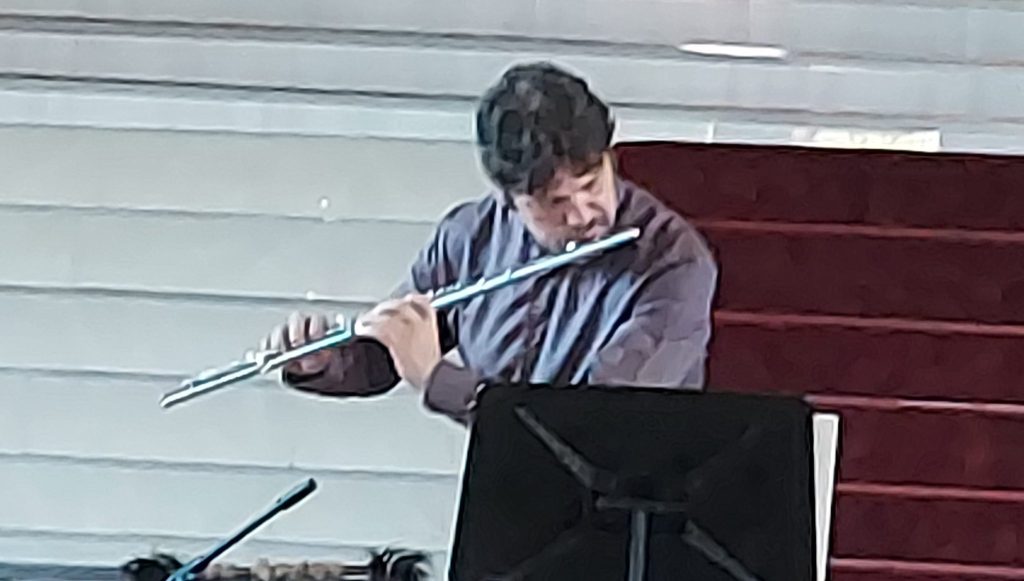
一个值得注意的表演是Ittzés对Robert Dick的”Lookout”的演绎,这是一部探索长笛延伸技巧的作品,包括复调音、颤舌和微分音等。Ittzés对这些技巧的精确控制以及他对作品的富有表现力的诠释,创造了令人着迷且引人入胜的听觉体验。作品对长笛声音可能性的探索突显了乐器的多功能性和表现潜力。Ittzés还演奏了他自己的作品”Fantasia”,展示了长笛在产生广泛音色和效果方面的能力。作品以其流畅的过渡和动态对比为特征,反映了传统非洲音乐的特质之一——“丰富的即兴演奏”。Ittzés的演奏技艺精湛,创新使用长笛延伸技巧,创造了丰富且引人入胜的听觉体验,展示了长笛在当代音乐中的创作潜力。
- 即兴表演和跨文化合作
即兴表演和跨文化合作是贯穿音乐节的关键主题,突显了现代音乐的自发性和协作性质。这些表演强调了文化交流的重要性和不同音乐传统的融合。
- 非洲传统音乐家
来自莱索托、加纳和乌干达的传统音乐家的表演是非洲音乐传统丰富性和多样性的见证。他们的即兴表演通常以交错的节奏和呼应模式为特点,吸引了观众的注意力,并提供了与非洲文化根源的深刻联系。
- 跨文化合作
跨文化合作是音乐节的一大亮点,不同背景的音乐家聚集在一起,创造出独特且创新的表演。这些合作强调了文化交流的重要性和不同音乐传统的融合。
一个值得注意的合作是巴斯克木琴打击乐手Oreka TX与乌干达打击乐手Bisaso Albert Ssempeke和James Isabirye的合作,由墨西哥作曲家Ernesto Martínez指导。他们的表演结合了巴斯克和乌干达的音乐元素,创造了令人着迷的文化碰撞,吸引了观众的注意力。不同打击乐器之间的交错节奏和旋律主题,创造了丰富且动态的音景,突显了跨文化合作的创新潜力。
另一个亮点是Simon Estes Alumni 合唱团的表演,由Monwabisi Mbambani指挥。合唱团由不同文化背景的歌手组成,表演曲目包括传统非洲合唱音乐、当代作品和通俗歌曲的改编。他们的表演展示了不同文化丰富的声乐传统,合唱音乐通过包含各文化、各名族特色的音乐体验将人们团结在一起。
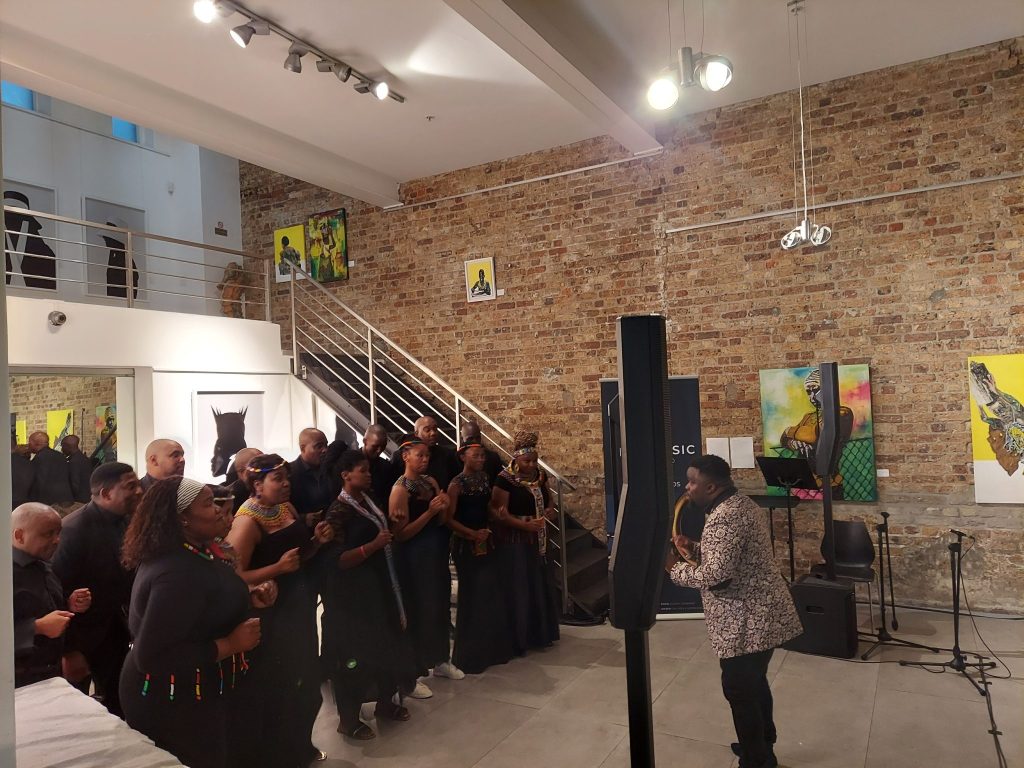
结论
2023年ISCM世界新音乐节在南非是一场标志性事件,庆祝并展示了了非洲丰富多样的音乐文化。音乐节为非洲音乐家提供了展示其才华的平台,也为国际观众提供了体验非洲独特音色和音乐表达的机会。通过将非洲传统元素与当代作曲技术相结合,音乐节突显了非洲音乐的创新潜力。
这场历史性事件不仅体现了国际当代音乐协会的百岁历程,还为未来的音乐节探索新领域和拥抱全球多样的音乐文化传统铺平了道路,为未来的活动树立了典范,突显了在保护文化遗产的同时拥抱创新和合作的重要性。我们期待未来的ISCM世界新音乐节能够继续促进全球文化交流,庆祝来自世界各地多种多样的当代音乐。此次活动为未来音乐节设定了高标准,并展示了在当代音乐世界中包容性和文化交流的重要性。
彭荣鑫
2024年1月于上海
